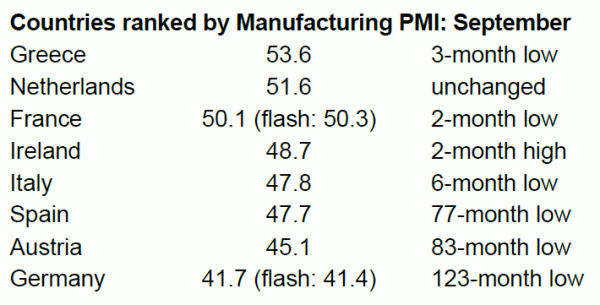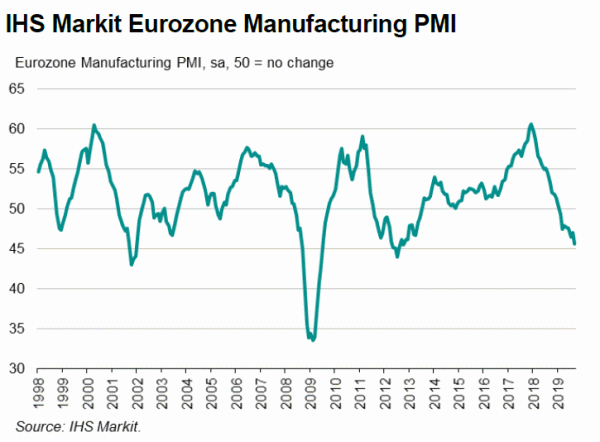Eurozone PMI Manufacturing was finalized at 45.7 in September, down from 47.0 in August. That’s the lowest level since October 2012. It’s also the eighth straight month of sub-50 reading, indicating that contraction continued. Markit also noted that output, new orders and purchasing all decline sharply during the month. Input costs also fell at the joint-sharpest rate since April 2016.
Looking at the member states, Germany PMI manufacturing hit 123-month low at 41.7. Austria hit 83-month low of 45.1. Spain hit 77-month low of 47.7. Italy hit 6-month low of 47.8. Ireland recovered to 2-month high at 48.7. Only readings of Franc (50.1), the Netherlands (51.6) and Greece (53.6) were above 50.
Commenting on the final Manufacturing PMI data, Chris Williamson, Chief Business Economist at IHS Markit said:
“The health of the eurozone manufacturing sector went from bad to worse in September, with the PMI survey indicating the steepest downturn for nearly seven years and sending increasingly grim signals for the fourth quarter.
“The September PMI points to manufacturing output falling at a quarterly rate in excess of 1%, representing a severe drag on GDP in the third quarter. Germany is leading the downturn, with the PMI down to levels not seen since 2009, but Italy and Spain are also in deepening downturns, whilst France’s manufacturing sector has stalled.
“There’s likely worse to come, with forward-looking indicators (such as the orders to-inventory ratio) deteriorating further during the month. Businesses also remain downbeat about the year ahead, with optimism around a seven-year low amid trade war worries, signs of slowing global economic growth and geopolitical concerns, including heightened anxiety over a disruptive Brexit.
“Adding to the gloom, jobs are now being cut at the fastest rate since early 2013, which is not only a sign of manufacturers bracing themselves for more trouble ahead, but also adds to the risk that a deteriorating labour market will hit households and the service sector.”














